From the Quad Cities to Paducah Kentucky
Davenport - Largest of the Quad Cities
We pulled off the I-80 freeway for the night on the northern edge of Davenport, Iowa, the largest of the Quad Cities (Davenport and Bettendorf in Iowa; Rock Island, Moline and East Moline across the Mississippi in Illinois - yes that is five cities). We found a interesting spot for a delicious dinner in the heart of downtown Davenport at Mantra Indian Cuisine and enjoyed getting there via the seven mile drive downtown along Northwestern Blvd and Harrison Street where there were plenty of Halloween decorations.
At one time, the Quad Cities were to tractors, combines and other farm equipment what Detroit was to automobiles in the 1950s. Following John Deere moving his factory to Moline in 1848, other names like Case, International Harvester, Moline, and Caterpillar all built plants in the area. Only John Deere, with headquarters in Moline, remains as a top ranked employer today. The New York Times chronicled some of the decline in this 1984 article.
The next morning, we returned to the downtown area to look at the LeClaire Park & band shell and the nearby Skybridge, both on the Mississippi riverfront. The band shell is an attractive music venue and perhaps we will come back one day for some summer entertainment.

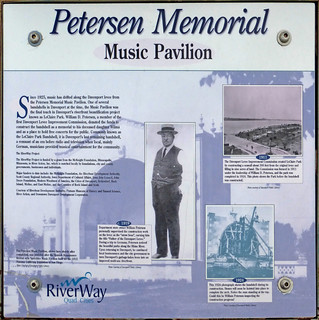

Nearby we visited the Bix Beiderbecke memorial. Bix must have been quite a musician judging from the quotes on the memorial from several prominent artists.
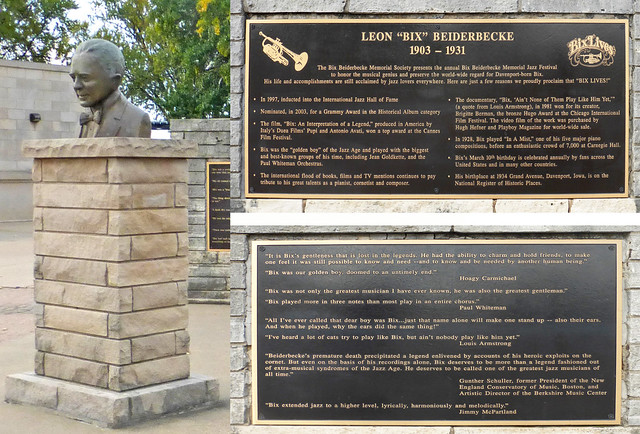
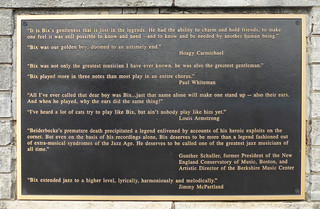
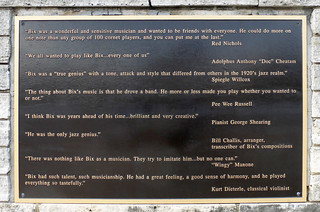
Also nearby, the Davenport sky bridge offers a great view of the park and river.
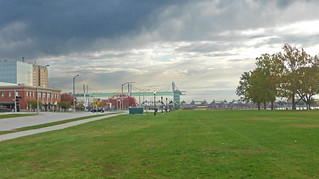
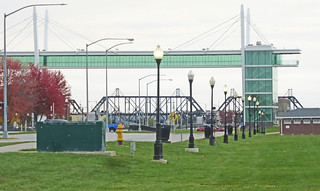
In the downtown area the prominent skyscraper makes one wonder what it is. It was originally built as the American Commercial and Savings Bank in 1927. It is now a luxury apartment complex.
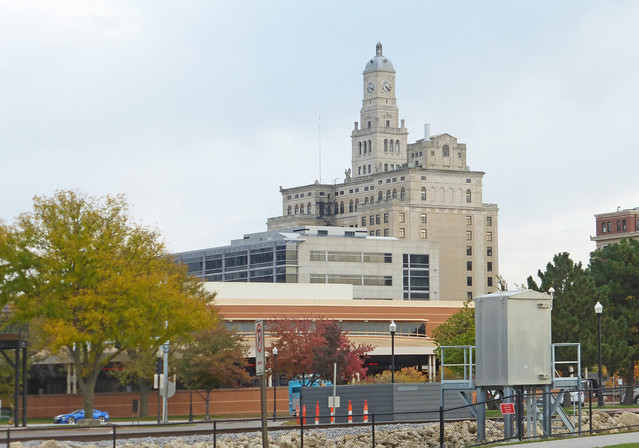
After that quick tour of the waterfront, we headed across the Centennial Bridge to Rock Island, Illinois. While Davenport appears to have survived the decline in manufacturing in the Quad Cities rather well, Rock Island appears to have not weathered the storm that produced our mid-western "Rust Belt."
A quick glance at the population trends for these two towns tells the story:
Rock Island has fallen from second most populous of the Quad Cities to fourth place and is likely headed to fifth.We were headed due south to Alton Illinois, about twenty miles north of St. Louis, MO, and would follow U.S. 67 to get there. This took us on a long tour of Rock Island along 11th street after passing through the downtown area at the foot of the bridge.
It was fortunate that we had stopped in Davenport and had dinner downtown the previous day, otherwise we likely would have bypassed the Quad Cities on I-280 and missed the closer look at the Davenport and Rock Island.
Rock Island - Where the Digital Computer Was Conceived in 1937
I have a particular interest in Rock Island but have never made it a point to visit the town. Rock Island is where the digital computer was conceived in the winter of 1937-38. Physics professor J. V. Atanasoff of Iowa State is officially credited as the inventor of the digital computer. During that cold winter, Atanasoff was frustrated at his lack of progress on his invention. He went for a drive (200 miles in his V-8 Ford!) to clear his head. Realizing that he had crossed the river into Illinois, it occurred to him that he could stop for an adult beverage. He pulled in at a Rock Island honkey-tonk. In a 1972 legal deposition he described the evening this way:
... I was able to think clearly; and, of course, the first thought that came to me was, again, a computing machine, and I sat there and worried about the computing machine for a number of hours.
As I rose to leave this place, I realized that I had made progress and that I had come to some conclusions as to how I would proceed in the solution of the problems which faced me ...
Atanasoff was never able to recall the specific honkey-tonk where he cleared his head - but he was sure it located in Rock Island. Several bars and a hotel have been suggested as the location but none have proof. He was recorded recalling the journey in this video titled "Atanasoff: Father of The Computer (Documentary)" on YouTube. (The ride to Rock Island begins at about 11:25)
A Canadian film crew was convinced that the honkey-tonk (or road-house or bar) was Hunter's on 4th Avenue. In this Vimeo video, the producer describes the hunt for the true location. It was convenient that they settled on Hunter's since the building was still operating at the time and they could film inside.
I took no pictures in Rock Island. The journey through the city and out 11th street was frankly a little depressing with the vacant lots and deteriorated buildings. There's a YouTube video that features a twenty minute tour of Rock Island created by Chris Harden; the title is: "A City That's On A Rocky Path: Rock Island, Illinois."
From Rock Island to Alton, Illinois.
Our next major stop was to be in Alton, Illinois. I wanted to stop there to see the monument that memorializes the seventh and final Lincoln-Douglas debate. But first we traveled across two hundred miles of pretty towns and farms along U.S. 67/267. This was a delightful break from the Interstate.
About a third of the way to Alton, we passed through the town of Industry, population about 400. Typical of the area, it had an attractive downtown and we paused to get a picture of the town's name on a sign on the outskirts. In addition to the downtown bank, a large grain storage facility was on the outskirts.

A mile or so north of the village, a small windmill sits in an area just off the highway, the only reminder of the Swearinger tourist camp in the area from 1927 to 1960. This newspaper clipping from the Bloomington (Illinois) Pantagraph recalls the day when there were seven gas stations in the Industry area - but only one with a windmill.
A bit farther along, a colorful leaf display surrounds a historical marker denoting one of Illinois' significant baseline survey points.
If you ever wondered about those "Principal Meridian" signs that you sometimes encounter, there is a short explanation here, and a long treatise here.
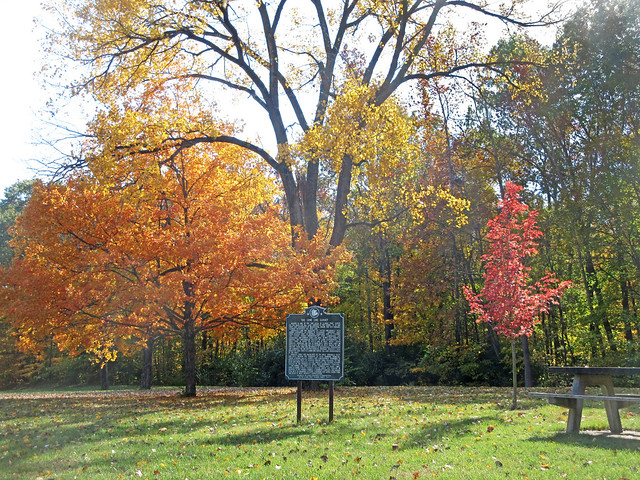
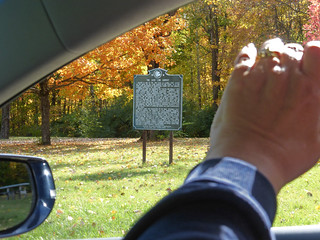
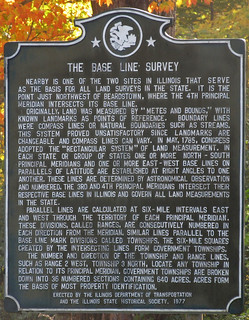
Alton, Illinois
Alton, Illinois, was on our second day's agenda because it was the site of the seventh and final Lincoln-Douglas debate during their 1858 campaign for Illinois Senator. Judge Douglas was the incumbent senator and Lincoln, a relative newcomer. The seven debates largely centered on the issue of slavery and its expansion into new territories. The city of Alton has a significant monument dedicated to the debate.
Lincoln-Douglas Senatorial Debate Schedule, 1858
Alton was an interesting location for the debate since it was a mere 20 miles from downtown St. Louis, the site of one of the most notorious American slave markets, “Lynch’s Slave Pen.”Alton Debate Plaza
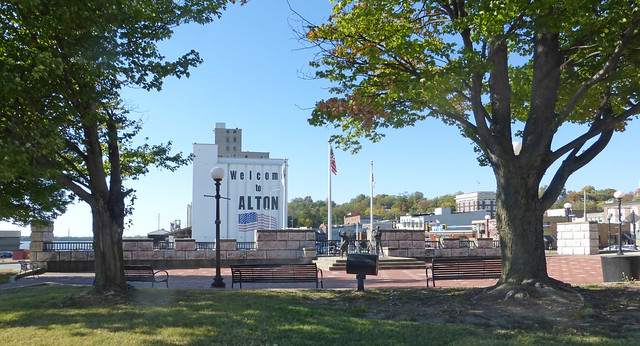
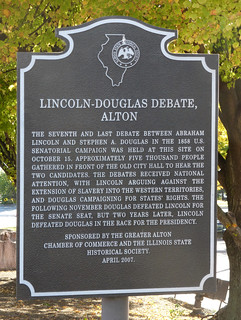
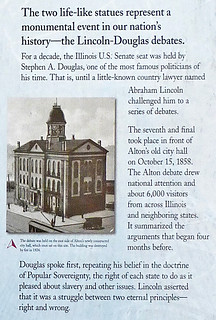
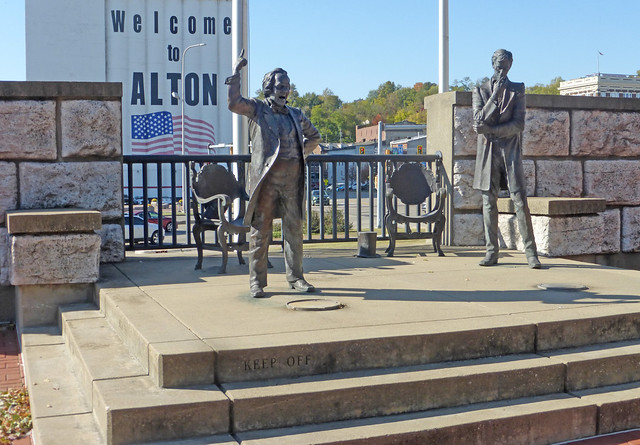
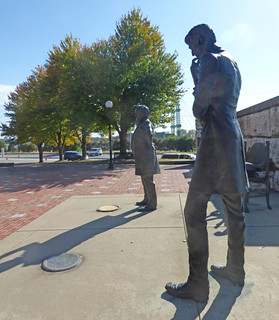
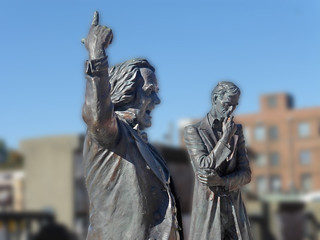
Local Debate Analysis
George T. Brown, the owner/publisher of the Alton Daily Courier, found the results decisive:
A less enthusiastic report was published about the previous debate in Quincy by the Quincy Daily Democrat:
Lincoln, in voice, emphasis and enunciation, has decidedly the advantage of Douglas. In fact, we were not only astonished but shocked at the failure of Douglas' voice.
... We have known them both intimately and well for more than twenty years. They are both men of a very high order of intellect, and fine social qualities.
... (Lincoln) is the embodiment of the principles of that party, and as such we are uncompromisingly and irreconcilably opposed to him.
Similar reports were published about Douglas' vocal efforts in Alton according to Lincoln scholar, Michael Burlingame:
When Douglas began his address, (one observer) “was really shocked at the condition he was in. His face was bronzed . . . but it was also bloated, and his looks were haggard, and voice almost extinct. In conversation he merely whispered. In addressing his audience he made himself understood only by an immense strain, and then only to a very small circle immediately near him.”
Final Election Results
At that time, U.S. senators were elected by the state legislatures. Because the Democrats carried 54 of the seats in the legislature, Judge Douglas squeaked by on a 54-46 vote, narrowly hanging onto his seat. But Lincoln had clearly established himself as a candidate with widespread appeal to many voters in the North - and made himself anathema to most voters in the South. In two years he would have a clear shot at the White House.
Suggested Reading
The fifth of the Lincoln Douglas debates took place at Galesburg, Illinois, where the "Old Main" building on the Knox College campus is the only surviving debate venue. Sadly, we had missed the opportunity to visit this site also. The Knox College website hosts the original manuscript of Lincoln scholar, Michael Burlingame's, massive biography: Abraham Lincoln: A Life. Chapter 13, "A David Greater than the Democratic Goliath": The Lincoln-Douglas Debates (1858) is devoted to the debates. Reading the chapter is a lesson in media bias and misinformation courtesy of newspaper which were the principal media of the day.
A subscription to Newspapers.com yields a wonderful source of information for contemporaneous reports of American events as perceived in towns, both small and large, over the 18th, 19th and 20th centuries. It is well worth the price although quite a few newspapers can be accessed for free at the Library of Congress newspaper site, Chronicling America.
On to Paducah,Kentucky
After leaving Alton, we stopped briefly to pick up a salad at an Alton grocery store (for later) and headed back onto the Interstate system and drove south to Kentucky for our next stop, Paducah, We crossed the Ohio river into Kentucky at dusk where the welcome sign was conveniently lighted for Linda to capture. Unfortunately, it's very out of focus. Paducah is another river town and we were able to find a room there at our favorite hotel chain, the Drury Inn.
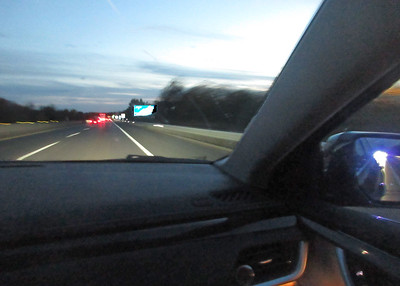
This was Monday night and the Vikings were playing San Francisco on Monday Night Football so we made sure to stop early enough to watch the game. We can't miss a game just because we're traveling. The Drury Inn offers a free evening buffet and $1 cocktails. Along with the earlier purchased salad, it was just what we needed to not miss any of the action of the game. The Vikings won!
More photos at this Flickr Album, of course.











No comments:
Post a Comment